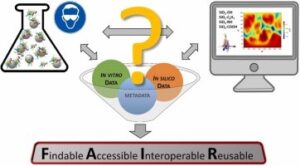Publication of the Month December
Computational prediction and experimental analysis of the nanoparticle-protein corona: Showcasing an in vitro–in silico workflow providing FAIR data
Ingrid Hasenkopf, Robert Mills-Goodlet, Litty Johnson, Ian Rouse, Mark Geppert, Albert Duschl, Dieter Maier, Vladimir Lobaskin, Iseult Lynch, Martin Himly
Abstract:
Extensive investigation and characterisation of nanoparticle-protein conjugates are imperative to assess potential nanoparticle-induced hazards for humans and the environment, predict adverse biological effects, and identify suitable nanoparticles for medical applications. Investigating the formation of the nanoparticle protein corona solely based on experimental analysis is currently very time-consuming and cost-intensive. Therefore, development of prediction tools based on in silico modelling is much-needed in order to provide viable alternative approaches and accelerate nanomaterial risk assessment at the early development stage. This work aimed to validate currently emerging in silico protein corona modelling tools with experimental results and to reveal the models’ potentials and limitations thereby contributing to the improvement of their predictive power. Comprehensive data and metadata sets of the obtained in vitro and in silico results were collected and annotated in the NanoCommons Knowledge Base to facilitate data Findability, Accessibility, Interoperability, and Reusability (FAIRness) in nanosafety assessment. In silico protein corona predictions (in silico modelling with UnitedAtom) and in vitro investigation of corona formation (binding and selectivity studies with eight different proteins, mixtures thereof, and an allergenic effector cell degranulation assay) on differently coated SiO2 nanoparticles were aligned and the results, in the first run, revealed substantial deviations. Therefore, we attempted to identify the potential and limitations in the modelling and provided recommendations to improve the model. Similar iteractive approaches, as described here, based on the verification versus rebuttal of data from in silico procedures by in vitro analyses, complemented by comprehensive data and metadata collection according to the FAIR principles, are expected to help optimise future prediction certainties and improve in silico modelling.

The open access article can be found here.
Reviewed by Hans Brandstetter
CONGRATULATIONS!





